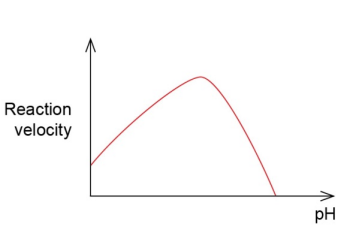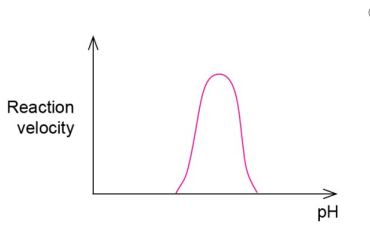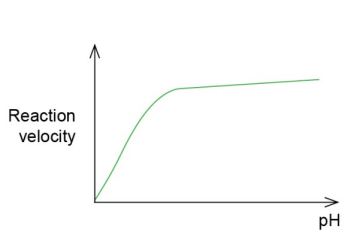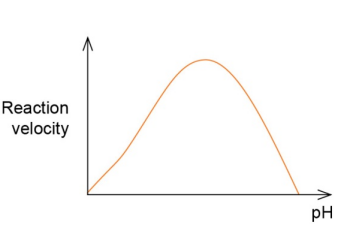HARD
Earn 100
Which of the diagrams illustrates the way in which the rate of an enzyme-controlled reaction depends on substrate concentration?
(a)

(b)

(c)

(d)

50% studentsanswered this correctly
Important Questions on Construct an explanation based on evidence for how the structure of DNA determines the structure of proteins which carry out the essential functions of life through systems of specialized cells.
EASY
Life Sciences>From Molecules to Organisms: Structures and Processes>Construct an explanation based on evidence for how the structure of DNA determines the structure of proteins which carry out the essential functions of life through systems of specialized cells.>Structure and Function - Systems of specialized cells within organisms help them perform the essential functions of life.All cells contain genetic information in the form of DNA molecules. Genes are regions in the DNA that contain the instructions that code for the formation of proteins, which carry out most of the work of cells.
EASY
Life Sciences>From Molecules to Organisms: Structures and Processes>Construct an explanation based on evidence for how the structure of DNA determines the structure of proteins which carry out the essential functions of life through systems of specialized cells.>Structure and Function - Systems of specialized cells within organisms help them perform the essential functions of life.All cells contain genetic information in the form of DNA molecules. Genes are regions in the DNA that contain the instructions that code for the formation of proteins, which carry out most of the work of cells.
Match the animals of Column with Column and select the correct options among the following:
| Column- | Column- | ||
| replication | polymerase | ||
| Translation | polymerase | ||
| Translation | Reverse transcriptase | ||
| Transcription | Aminoacyl synthetase |
Select the code for the correct answer from the options given below.
MEDIUM
Life Sciences>From Molecules to Organisms: Structures and Processes>Construct an explanation based on evidence for how the structure of DNA determines the structure of proteins which carry out the essential functions of life through systems of specialized cells.>Structure and Function - Systems of specialized cells within organisms help them perform the essential functions of life.All cells contain genetic information in the form of DNA molecules. Genes are regions in the DNA that contain the instructions that code for the formation of proteins, which carry out most of the work of cells.
MEDIUM
Life Sciences>From Molecules to Organisms: Structures and Processes>Construct an explanation based on evidence for how the structure of DNA determines the structure of proteins which carry out the essential functions of life through systems of specialized cells.>Structure and Function - Systems of specialized cells within organisms help them perform the essential functions of life.All cells contain genetic information in the form of DNA molecules. Genes are regions in the DNA that contain the instructions that code for the formation of proteins, which carry out most of the work of cells.
HARD
Life Sciences>From Molecules to Organisms: Structures and Processes>Construct an explanation based on evidence for how the structure of DNA determines the structure of proteins which carry out the essential functions of life through systems of specialized cells.>Structure and Function - Systems of specialized cells within organisms help them perform the essential functions of life.All cells contain genetic information in the form of DNA molecules. Genes are regions in the DNA that contain the instructions that code for the formation of proteins, which carry out most of the work of cells.
MEDIUM
Life Sciences>From Molecules to Organisms: Structures and Processes>Construct an explanation based on evidence for how the structure of DNA determines the structure of proteins which carry out the essential functions of life through systems of specialized cells.>Structure and Function - Systems of specialized cells within organisms help them perform the essential functions of life.All cells contain genetic information in the form of DNA molecules. Genes are regions in the DNA that contain the instructions that code for the formation of proteins, which carry out most of the work of cells.
MEDIUM
Life Sciences>From Molecules to Organisms: Structures and Processes>Construct an explanation based on evidence for how the structure of DNA determines the structure of proteins which carry out the essential functions of life through systems of specialized cells.>Structure and Function - Systems of specialized cells within organisms help them perform the essential functions of life.All cells contain genetic information in the form of DNA molecules. Genes are regions in the DNA that contain the instructions that code for the formation of proteins, which carry out most of the work of cells.
EASY
Life Sciences>From Molecules to Organisms: Structures and Processes>Construct an explanation based on evidence for how the structure of DNA determines the structure of proteins which carry out the essential functions of life through systems of specialized cells.>Structure and Function - Systems of specialized cells within organisms help them perform the essential functions of life.All cells contain genetic information in the form of DNA molecules. Genes are regions in the DNA that contain the instructions that code for the formation of proteins, which carry out most of the work of cells.
EASY
Life Sciences>From Molecules to Organisms: Structures and Processes>Construct an explanation based on evidence for how the structure of DNA determines the structure of proteins which carry out the essential functions of life through systems of specialized cells.>Structure and Function - Systems of specialized cells within organisms help them perform the essential functions of life.All cells contain genetic information in the form of DNA molecules. Genes are regions in the DNA that contain the instructions that code for the formation of proteins, which carry out most of the work of cells.
DNA -ATGCATGCATGC -
EASY
Life Sciences>From Molecules to Organisms: Structures and Processes>Construct an explanation based on evidence for how the structure of DNA determines the structure of proteins which carry out the essential functions of life through systems of specialized cells.>Structure and Function - Systems of specialized cells within organisms help them perform the essential functions of life.All cells contain genetic information in the form of DNA molecules. Genes are regions in the DNA that contain the instructions that code for the formation of proteins, which carry out most of the work of cells.
Two of the following statements are correctly defined. Identify the correct combination
i) Conversion of hnRNA to mRNA - processing
ii) Removal of introns and joining of exons - splicing
iii) Addition of adenylate residues to - end in a template dependent manner - Tailing
iv) Methyl adenosine triphosphate is added to - end of hnRNA - capping
MEDIUM
Life Sciences>From Molecules to Organisms: Structures and Processes>Construct an explanation based on evidence for how the structure of DNA determines the structure of proteins which carry out the essential functions of life through systems of specialized cells.>Structure and Function - Systems of specialized cells within organisms help them perform the essential functions of life.All cells contain genetic information in the form of DNA molecules. Genes are regions in the DNA that contain the instructions that code for the formation of proteins, which carry out most of the work of cells.
A) Expressed sequences of eukaryotic genes are exons
B) Intervening gene sequences of eukaryotes that do not appear in processed RNA are cistrons
C) Process of removal of introns and joining of exons in defined order is splicing
D) Monocistronic transcriptional unit has only exons
MEDIUM
Life Sciences>From Molecules to Organisms: Structures and Processes>Construct an explanation based on evidence for how the structure of DNA determines the structure of proteins which carry out the essential functions of life through systems of specialized cells.>Structure and Function - Systems of specialized cells within organisms help them perform the essential functions of life.All cells contain genetic information in the form of DNA molecules. Genes are regions in the DNA that contain the instructions that code for the formation of proteins, which carry out most of the work of cells.
EASY
Life Sciences>From Molecules to Organisms: Structures and Processes>Construct an explanation based on evidence for how the structure of DNA determines the structure of proteins which carry out the essential functions of life through systems of specialized cells.>Structure and Function - Systems of specialized cells within organisms help them perform the essential functions of life.All cells contain genetic information in the form of DNA molecules. Genes are regions in the DNA that contain the instructions that code for the formation of proteins, which carry out most of the work of cells.
MEDIUM
Life Sciences>From Molecules to Organisms: Structures and Processes>Construct an explanation based on evidence for how the structure of DNA determines the structure of proteins which carry out the essential functions of life through systems of specialized cells.>Structure and Function - Systems of specialized cells within organisms help them perform the essential functions of life.All cells contain genetic information in the form of DNA molecules. Genes are regions in the DNA that contain the instructions that code for the formation of proteins, which carry out most of the work of cells.
MEDIUM
Life Sciences>From Molecules to Organisms: Structures and Processes>Construct an explanation based on evidence for how the structure of DNA determines the structure of proteins which carry out the essential functions of life through systems of specialized cells.>Structure and Function - Systems of specialized cells within organisms help them perform the essential functions of life.All cells contain genetic information in the form of DNA molecules. Genes are regions in the DNA that contain the instructions that code for the formation of proteins, which carry out most of the work of cells.
MEDIUM
Life Sciences>From Molecules to Organisms: Structures and Processes>Construct an explanation based on evidence for how the structure of DNA determines the structure of proteins which carry out the essential functions of life through systems of specialized cells.>Structure and Function - Systems of specialized cells within organisms help them perform the essential functions of life.All cells contain genetic information in the form of DNA molecules. Genes are regions in the DNA that contain the instructions that code for the formation of proteins, which carry out most of the work of cells.
EASY
Life Sciences>From Molecules to Organisms: Structures and Processes>Construct an explanation based on evidence for how the structure of DNA determines the structure of proteins which carry out the essential functions of life through systems of specialized cells.>Structure and Function - Systems of specialized cells within organisms help them perform the essential functions of life.All cells contain genetic information in the form of DNA molecules. Genes are regions in the DNA that contain the instructions that code for the formation of proteins, which carry out most of the work of cells.
EASY
Life Sciences>From Molecules to Organisms: Structures and Processes>Construct an explanation based on evidence for how the structure of DNA determines the structure of proteins which carry out the essential functions of life through systems of specialized cells.>Structure and Function - Systems of specialized cells within organisms help them perform the essential functions of life.All cells contain genetic information in the form of DNA molecules. Genes are regions in the DNA that contain the instructions that code for the formation of proteins, which carry out most of the work of cells.
In the given transcription unit, identify the regions and respectively. Coding strand

MEDIUM
Life Sciences>From Molecules to Organisms: Structures and Processes>Construct an explanation based on evidence for how the structure of DNA determines the structure of proteins which carry out the essential functions of life through systems of specialized cells.>Structure and Function - Systems of specialized cells within organisms help them perform the essential functions of life.All cells contain genetic information in the form of DNA molecules. Genes are regions in the DNA that contain the instructions that code for the formation of proteins, which carry out most of the work of cells.
HARD
Life Sciences>From Molecules to Organisms: Structures and Processes>Construct an explanation based on evidence for how the structure of DNA determines the structure of proteins which carry out the essential functions of life through systems of specialized cells.>Structure and Function - Systems of specialized cells within organisms help them perform the essential functions of life.All cells contain genetic information in the form of DNA molecules. Genes are regions in the DNA that contain the instructions that code for the formation of proteins, which carry out most of the work of cells.

